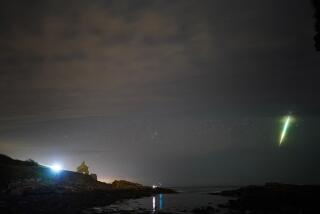MOORPARK : Lunar Eclipse Viewing
Weather permitting, Ventura County residents will be able to see the eerie orange glow of the moon at full lunar eclipse Sunday night for the first time since 1982.
Astronomers say the event, though not as rare as a solar eclipse, is much more beautiful. As the moon dips into the innermost part of the Earth’s shadow--the umbra--its pale gray glow will change to an orange copper color.
“Even though it happens more frequently, this is much more visually interesting than a solar eclipse,” said Moorpark College astronomy instructor Hal Jandorf. “It lasts much longer, and as the light is refracted by the earth, the colors change to a beautiful but eerie rust orange.”
For $2, stargazers can check out the sight through one of 30 telescopes that will be set up at the Moorpark College Observatory. The “Evening Under the Stars” is co-sponsored by the Ventura Astrological Society and includes a lecture and information on the valleys and craters on the moon’s surface.
The event begins at 7:30 p.m. The moon will first pass into the earth’s shadow at 8:40 p.m. with total eclipse at 10:02 p.m. The moon will pass out of the earth’s shadow at 10:50 p.m.
To reach the Moorpark College Observatory, take the Collins Drive exit north off California 118. Turn right on Campus Drive, then turn right into the observatory parking lot at the second stop sign.
In the Dark
Weather permitting, people in California and the West will be able to witness what is expected to be a particularly graphic total lunar eclipse Sunday, as the moon passes through Earth’s shadow.
Timing: Astronomers at Griffith Observatory say the eclipse is well-timed for West Coast residents because it will occur late in the evening, when the moon is higher in the sky.
Other eclipses: It will be the first total eclipse visible in Los Angeles since June 4, an event obscured locally by clouds. The next total lunar eclipse visible in the Los Angeles area will occur in September, 1996.
Best View: Although the moon will enter the faintest fringe of Earth’s shadow at 7:27 p.m., the best viewing will be after 8:40, when it begins to slip into the dark inner shadow. The moon should be completely obscured for 48 minutes, starting at 10:02 p.m.
UMBRA (Darkest part of Earth’s shadow)
All times are Pacific Standard Time 1:25 a.m.: MOON LEAVES PENUMBRA 12:12 a.m.: MOON LEAVES UMBRA 10:50 p.m.: TOTAL ECLIPSE ENDS 10:02 p.m.: TOTAL ECLIPSE BEGINS 8:40 p.m.: PARTIAL ECLIPSE BEGINS 7:27 p.m.: MOON ENTERS PENUMBRA PENUMBRA (Outer fringe of Earth’s shadow) Sources: Sky & Telescope Magazine, Griffith Observatory
More to Read
Sign up for The Wild
We’ll help you find the best places to hike, bike and run, as well as the perfect silent spots for meditation and yoga.
You may occasionally receive promotional content from the Los Angeles Times.






